Running training
Training planning for beginners
If you are a beginner or have not done any sport for a long time, you need time and patience to improve your endurance. It is much better to run for 20 minutes a day or 30-40 minutes three times a week than twice an hour at the weekend. The following steps will help you to realistically achieve your goal of running for an hour at a time:
Step 1: Plan three training sessions into your diary (e.g. Tuesday, Thursday, Saturday).
Step 2: Set a realistic goal that is achievable within a few months (e.g. run for an hour at a time)
Step 3: Get the right equipment in a specialist shop with advice.
Step 4: Supplement the (three) training sessions with 2-3 strength training sessions per week.
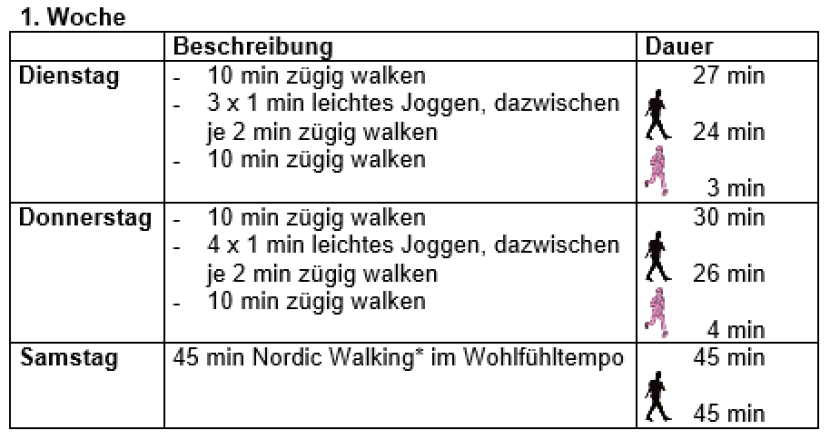
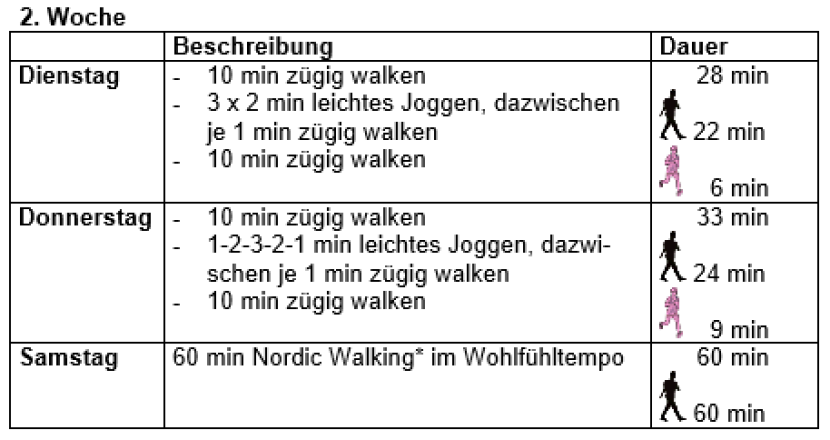
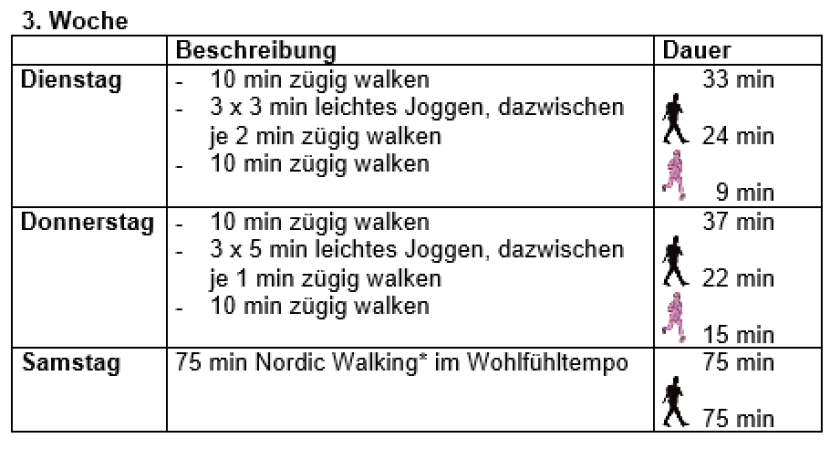
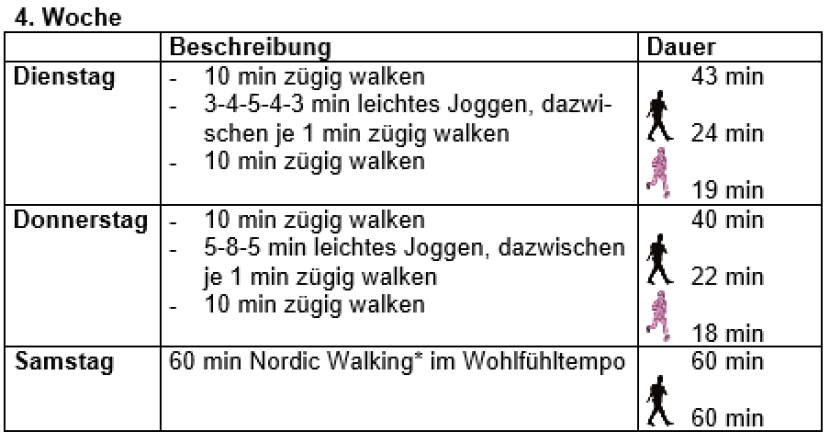
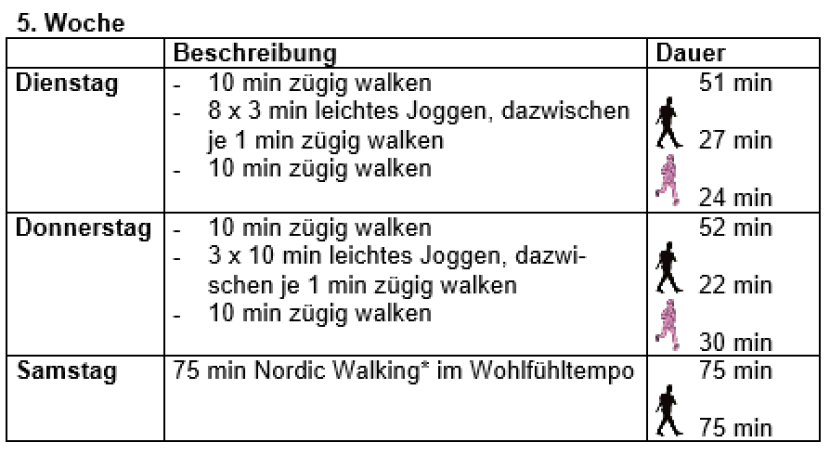
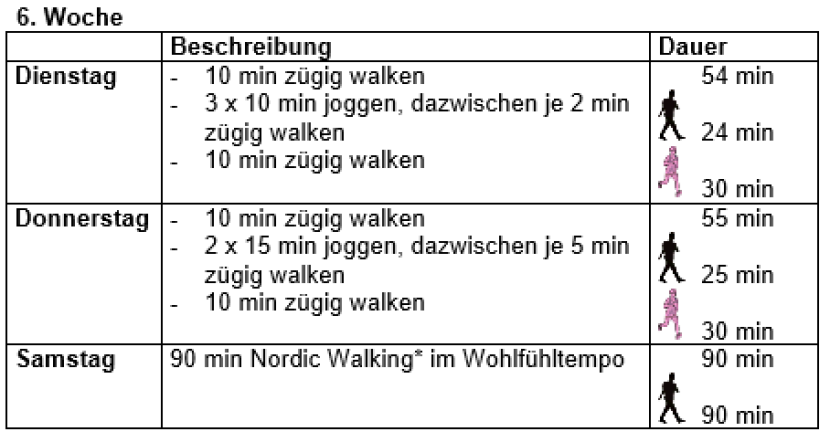
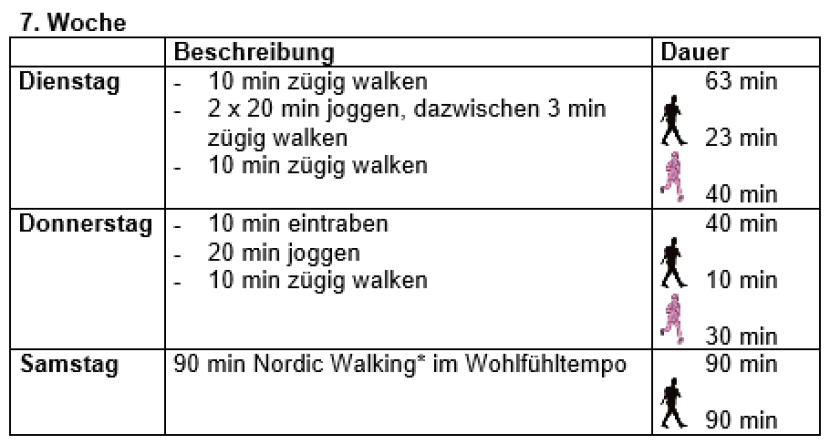
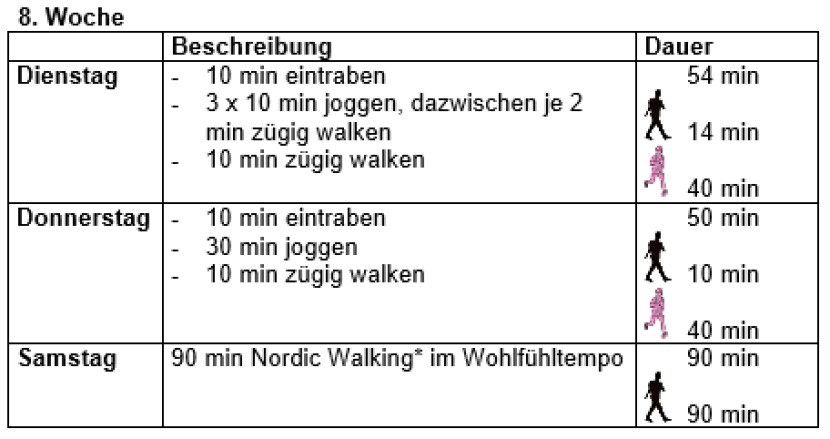
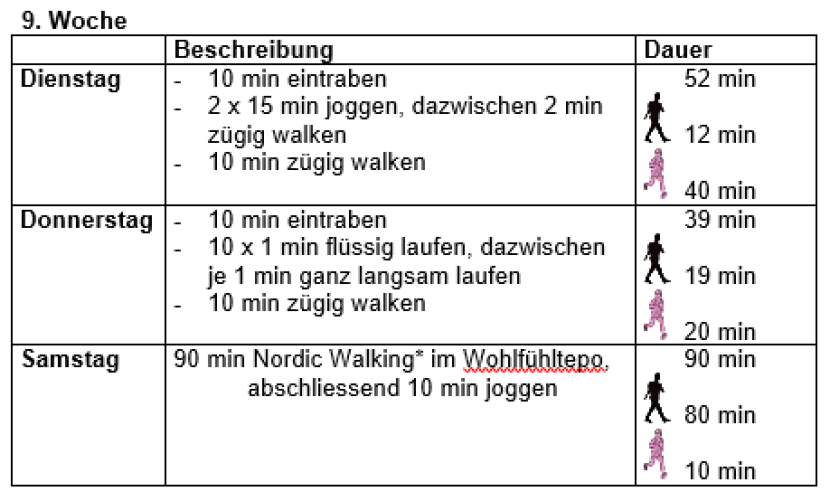
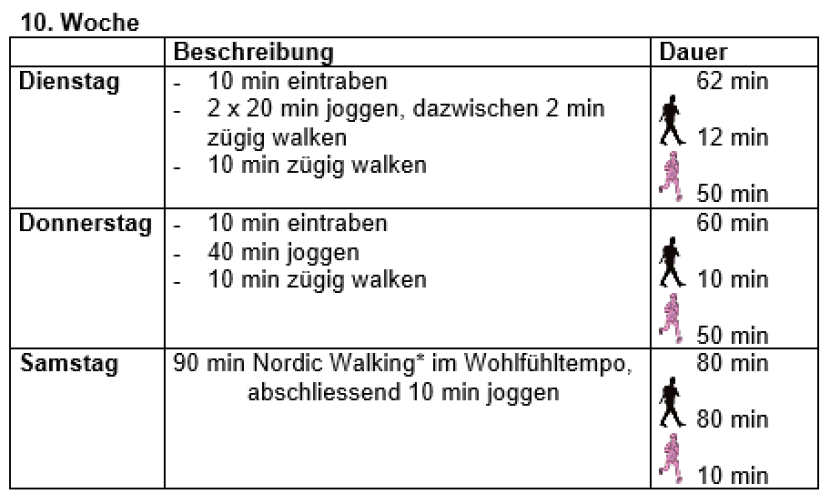
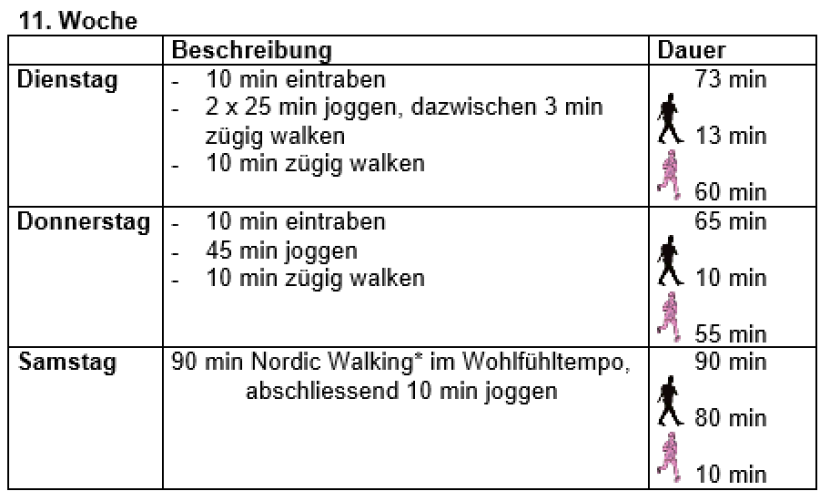
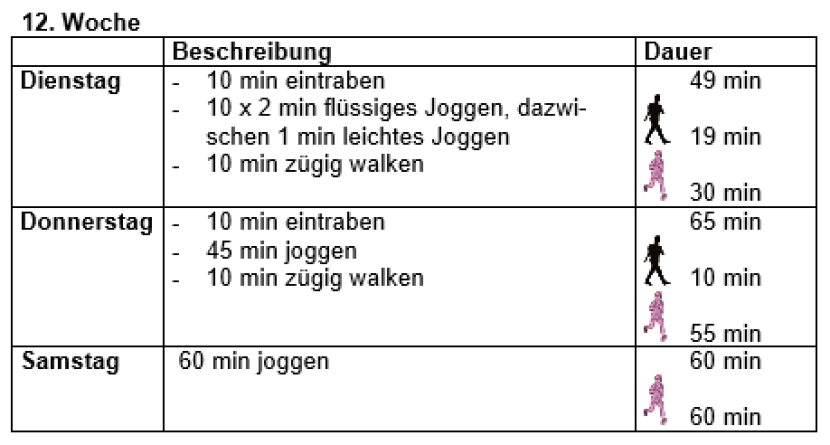
If the programme progresses too quickly, weeks 3 and 4 or 6 and 7 can be repeated. The Nordic walking sessions (*) can alternatively be replaced with aqua fitness, swimming, cycling or inline skating.
A regular strength training programme is one of the prerequisites for running without pain and an efficient running style. However, strength training is also a very good recipe for combating poor posture. You don't necessarily need a fitness centre for strength training, as exercises with your own body weight are generally sufficient. The most important strength training exercises should be planned into your weekly programme on two to three days. For example, every time after running before getting into the shower, or shorten your running training now and again in favour of a ten-minute strength sequence. Strength training also increases the basal metabolic rate, which means that the energy requirement that the body already needs without activity increases, which will have a positive effect on body weight. An optimal combination of cardiovascular and strength endurance training is offered by a Vitaparcours, for example.
Running training and everyday habits put one-sided strain on our skeletal muscles, which can lead to functional shortening of the muscles. This can result in evasive movements and incorrect loading, which in turn can cause overloading of other structures such as ligaments, tendons and neighbouring muscle groups. This can lead to pain or injuries. Stretching, in combination with strengthening exercises, helps to prevent injuries by restoring the normal basic tension of the muscles.
Principles for running training
Group training
Running in a team or with a team mate is easier at the beginning, so you can utilise the experience of others and talk to each other while running. The motto is: hear-see-recognise-understand-experience, together whenever possible. It is important to run consciously and to include nature as a motivating factor in your training. Choose a varied route with lots of natural roads so that running is fun. Every run should be an experience or learning experience. For sports leaders, this means a great challenge that is appreciated by the participants. The leader focusses on the weakest and not the strongest. It helps to form performance groups, as the level of the runners can be extremely varied. This prevents participants from being over- or underchallenged.
Clothing
Make sure you wear light and breathable clothing. Sweat should be able to be wicked away through the clothing so that the body does not feel wet. Basically, it can be said that there is no such thing as bad weather for running, only unsuitable clothing.
When buying shoes, pay attention:
Heel stability. The shoe must fit very well at the heel and must not slip.
Toe freedom must be guaranteed. If in doubt, buy the shoe a little (1/2 size) too big.
When buying new running shoes, take the old ones with you to be analysed and seek advice from a specialist (e.g. reinforcement of the shoe if one side is too worn).
Running style
There are basically three different running styles:
The heel runner: the most common running style, suitable for longer distances
The midfoot runner: this style is becoming increasingly popular. Its advantage lies in the fact that the impact load on the midfoot is the lowest, which reduces the susceptibility to injury to the Achilles tendon, ankle, knee and hip joints.
The forefoot runner (bunion runner): mainly sprinters run this way, but inclines are also mastered in this way.
To give runners a better understanding of their running style, it is advisable to experience the different styles under guidance.
A light and relaxed running style is very important and prevents postural damage and injuries. When running, the torso is always upright and slightly bent forwards. It stabilises the running movement, which requires good core muscles. The arms are bent and the hands are slightly open. The shoulders and neck should be relaxed and actively involved in the movement.
Breathing
Regular breathing in rhythm with the running movement improves cardiovascular activity (endurance). Please note this:
The body regulates its oxygen requirements automatically. Breathing adapts automatically to the rhythm of your stride. During exertion, the body gets the air it needs by breathing quickly.
It breathes in through the nose and out through the mouth.
Pay particular attention to deep, complete exhalation. This ensures improved exhalation of the carbon dioxide (abdominal breathing).
Overexertion
Overexertion should be avoided at all costs. It is important to interpret the body's signals correctly and deal with them. That is why you should never run faster than an increase in performance of at least 10% is possible at any time.
A good training effect is achieved if you train regularly (e.g. 3-4 x 30 minutes per week). Only one training session of a longer duration (e.g. 90 minutes) is not recommended, as this could lead to overexertion and have a counterproductive effect. Stretching exercises before and after each workout improve your personal range of motion and can reduce the risk of injury.
Pulse control
The following rule of thumb applies to the average amateur athlete: training heart rate = 220 (women 226) minus age, 70-85% of which is the target heart rate zone. For example, a runner aged 20 who wants to improve their fitness level must train between 140 and 170 heart rate beats.
The difference between the training heart rate and the recovery heart rate (immediately 2 minutes after the end of training) should be measured to check endurance capacity. Differences of 60 beats or more indicate a very good level of endurance training. Note: The higher the performance heart rate, the greater the difference in heart rate should be.
Discomfort
Side stitch
Lateral stitch is not a disease. Occasionally, stitch-like discomfort can be felt on the left or right side of the abdominal area just a few minutes after starting to run.
The actual causes of this frequently encountered phenomenon are still not exactly known. Some studies suggest that this may be a purely mechanical cause. The connective tissue that supports the abdominal organs is under much greater strain after a meal. Physical activity at this time can cause minor tissue tears and bleeding. Other explanations include insufficient oxygen supply to the diaphragm or pain caused by blood redistribution in the spleen or liver.
Possible measures to prevent side stitches can be:
Training the abdominal muscles. Weak abdominal muscles increase the risk of side stitches.
No food intake (1-2 hours) before training or competition, only liquid food (non-carbonated) or very easily digestible food.
Possible measures for side stitches:
Interrupt training and press inhaled air into the lungs for 5-10 seconds in a crouching position. Repeat the process several times.
Continue running at a reduced pace and change your breathing rhythm until the pain has disappeared.
Cramp
Muscles are structured in such a way that when they contract (muscle work), elements in the muscle cells push into each other. A short time later, they release again so that the same process can be repeated if necessary. A (muscle) cramp is an unintentional, painful muscle contraction.
Cramps have various causes such as mineral deficiency (e.g. as a result of excessive alcohol consumption), metabolic disorders, poor circulation, side effects of medication, hypothyroidism, nerve damage, overstraining of the muscles or orthopaedic causes (e.g. foot misalignment). Muscle cramp often occurs without any recognisable cause. A common cause of muscle cramps typical of sport is magnesium deficiency. The cause of muscle cramps at rest can be a lack of calcium in the blood.
The PECH rule recommended for muscle and joint injuries is rather unsuitable for muscle cramps. In particular, cooling is not recommended for the treatment of muscle cramps. Rest and elevation, on the other hand, can contribute to pain relief and regeneration. To treat the cramp, the extent of movement of the joint should be utilised so that the muscle can shorten in order to prevent the tendon reflex from being triggered again. Then tense the antagonist, as this inhibits the spasming muscle via a recurrent neurone in the spinal cord. A gentle relaxing massage or heat treatment can also help to relieve acute muscle pain. A cramp can often be stopped by stretching the affected muscle. In the case of calf cramp, for example, this can be done by positioning the front foot of the affected leg on a raised surface or stretching the leg backwards and putting weight on it.
To prevent cramps during or after physical activity, it is often recommended to drink plenty of fluids before, during and after exercise. Calcium-rich drinking water contains sufficient calcium, but cannot replenish the body with all the salts and minerals excreted with sweat. This is usually achieved through a healthy and balanced diet. Fruit juices and mineral waters can provide a quick balance if they contain sufficient sodium (chloride), potassium and magnesium. The content of these substances should also be taken into account in so-called isotonic drinks. Sports drinks often only achieve a short-term improvement in well-being due to the sugar they contain. However, the intake of isolated sugars often causes a fluctuation in blood sugar levels, which can also have a counterproductive effect.
As the causal relationships between cramps caused by physical activity have not yet been clarified, cramps during sport can only be ruled out for the time being by avoiding unusual exertion. This means that the exertion (even during competitions) must not be different or significantly more intense than during regular training.
Sore muscles
Muscle soreness occurs after overstraining the muscles. If the muscles are subjected to an unusual and usually eccentric load, the muscle fibres can be stretched, which can cause small tears in the myofibrils of the muscle fibres. These micro-tears lead to inflammation, which triggers the noticeable pain. The symptoms occur 12-24 hours after exercise. Muscle soreness can be prevented by slowly increasing the training, carefully introducing eccentric loads and toning the muscles beforehand. Unfamiliar loads should be approached slowly and the intensity should never be increased at the same time as the volume. Once the pain is there, light activity, warmth and a gentle massage can alleviate the pain and speed up the healing process. In any case, intensive training should be avoided. Muscle soreness cannot be prevented by stretching after sport and is not a prerequisite for triggering a training effect.
Gastrointestinal problems
Gastrointestinal problems during training or competition plague more than half of all endurance athletes. The symptoms are not usually dangerous, but they are extremely unpleasant. In rare cases, however, the cause of gastrointestinal problems during training or competition may require medical examination and treatment.
The gastrointestinal tract is sensitive to stress, which also manifests itself in everyday life. For example, tension before a competition has an effect on the autonomic nervous system, resulting in diarrhoea, acid regurgitation or a feeling of knots in the stomach. The increased stress inhibits gastric motility and overstimulates intestinal activity. Not only the tension before a competition, but also the increased stress during training or a competition can trigger the same symptoms. The higher the intensity or the greater the duration of the exercise, the more severe the symptoms can be. Another cause of discomfort is the reduction in blood flow in the digestive organs during sporting activity. This reduction can be up to 80%. The reduced blood flow decreases the activity of the digestive organs, which can lead to functional disorders and even serious complaints such as inflammation of the mucous membranes, ulcers or bleeding. The negative effects are exacerbated by fluid loss and poor acclimatisation to the environment and training conditions.
Runners are the group most affected by gastrointestinal problems in endurance sports. 30-40% of runners regularly suffer from urge to defecate during exercise, 15-30% from diarrhoea. The direct correlation between intensity and severity of the symptoms can also be clearly observed here: The greater the exertion, the greater the risk of negative effects on the gastrointestinal system. In many cases, the symptoms can be avoided with a targeted diet. Another measure to avoid gastrointestinal problems is to carefully approach high-intensity exercise so that the gastrointestinal tract has the opportunity to adapt to the physical exertion. If, despite taking precautions, the symptoms keep recurring during extreme exercise, a temporary reduction in volume or intensity by 10-20% can help. Furthermore, the ability to consume and tolerate food, at least in liquid form, during exercise can be trained and should be a regular part of long training sessions in all long-term endurance sports. If you regularly suffer from diarrhoea during exercise, you can try to move your training directly to the time after your spontaneous daily bowel movement without eating in between.
The basic rules for nutrition before exercise are:
Have your last big meal 3-4 hours before exercise
Include easily digestible, non-flatulent, low-fat foods
If you are sensitive, consume only small amounts of liquids or tolerable food before the competition
Water or lightly sweetened tea with white bread are better tolerated than bars or energy drinks
During sport, drinking small amounts of fluids can minimise gastrointestinal problems. Sensitive people should exercise great caution with food concentrates; it is better to opt for natural foods. Every endurance athlete should refrain from taking mineral tablets or powders before and during exercise, as these can lead to diarrhoea if the dosage is too high. Food tolerance tests can be incorporated into training, but it is not advisable to experiment during competitions.
It is not advisable to eat large quantities of food immediately after a competition, as the gastrointestinal system also needs to recover first.
Runner's knee
The knee is the most heavily loaded joint of the runner. If the knee hurts, this is usually due to overloading of tendons, ligaments, muscles, meniscus or cartilage. In most cases, it is the end of a long-term development in which a minor trauma is sufficient to cause discomfort. The trigger is just the straw that broke the camel's back. In most cases, leg misalignments (bow legs), muscular imbalances caused by incorrect loading of individual structures, incorrect training or monotonous strain are found.
Common mistakes include training too quickly, running on hard surfaces with poorly cushioned or worn shoes, not warming up and stretching enough. However, overloading due to excessive running volumes, constant training on tracks with sloping edges, intensive track training without changing running direction and too many uphill runs can also be causes of knee problems.
Under normal conditions, the tractus iliotibialis glides past the outer knee joint space when the knee is bent and extended. In runner's knee, however, it is usually shortened and therefore rubs across the lower end of the thigh bone. This leads to inflammation of the tissue rubbing against each other
Symptomatic cooling and anti-inflammatory medication help with treatment. Imbalances must be compensated for by training the weak muscles and shortened structures must be stretched intensively and consistently over a longer period of time. In the case of Runne's Knee, training often has to be reduced or avoided altogether in the short term. The use of bandages or kinesio taping can have a supportive effect during training. It can be helpful to have your running style checked by an expert (with video support) in order to compensate for any problems by changing your shoes or using insoles.
Achillodynia
Achillodynia, pain in the Achilles tendon or its surrounding tissue, can be extremely unpleasant and make every step a pain. The Achilles tendon connects the heel bone to the calf muscles. Shearing and stretching forces acting on the tendon are the main cause. Overloading is the most common cause of achillodynia, but overpronation (increased inward rotation) of the foot can also be a cause of the complaint. Overpronation of the foot causes additional strain on the tendon. This results in an inflammatory reaction of the tendon and the surrounding tissue as well as increasing tension and shortening of the calf muscles.
Treatment involves anti-inflammatory agents (compresses) or massage to improve circulation. An independent massage of the calf muscles with the thumb (large circumference) can also be helpful. Shoe insoles (silicone) are worth considering to counteract the problem of achillodynia.
Pain in the tibial crest
Stress that is not adapted to the training condition or overloading can lead to periostitis on the tibia. Another reason is a mechanical misalignment such as hyperpronation of the foot, which leads to a flattening of the arch of the foot, the inner ankles lean inwards and the rolling of the foot is disturbed.
In the case of tibial crest pain, it is important to reduce training or switch to swimming training. Stretching exercises and cooling are used for treatment. It may be necessary to correct the heel position.
Blisters
Blisters occur when the feet are hot and sweaty and the socks/stockings stick to the skin. The socks/stockings and skin rub against each other in the shoe. Layers of skin separate from each other and fluid forms in the gaps. This fluid protects the tissue like a small balloon.
A few points can be observed as prophylaxis: Shoes should be chosen that are sufficiently wide, comfortable, fit well, are made of soft material and have good foot bedding. It is important to keep the feet as dry as possible, which is why no damp shoes or socks/stockings should be worn. The shoes and socks/stockings should fit perfectly. Even the slightest unevenness in the socks/stockings, such as creases or grains of sand, can cause a blister. Good skin care is also extremely important. Sensitive areas of skin should be rubbed with Vaseline, milking fat or skin oil, for example, especially before sport, so that the skin is more supple and far less susceptible to friction.
A small unopened blister usually heals by itself. The uninjured upper layer of skin acts practically like a sterile bandage. A large blister should be punctured by a doctor using a sterile needle. If an athlete notices that a blister is forming, the area can be protected with a plaster that is applied without creases. Even if the blister has burst, the top layer should not be removed as it can also act as a protective bandage. However, it should also be cleaned with an aseptic solution and covered with a sterile dressing. Special blister plasters are particularly suitable for prevention and treatment, as they support natural healing and protect against pressure and pain like a second skin.
Foot care tips
Regular foot inspection/care
Wash your feet daily
Cut toenails straight and not too short
Only shoes that really fit properly
Change shoes more often
Careful with old household remedies